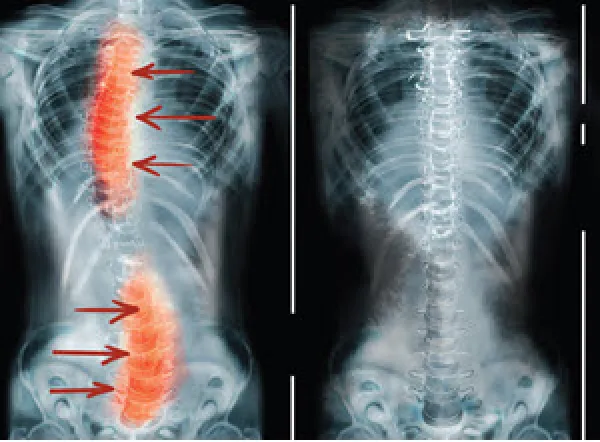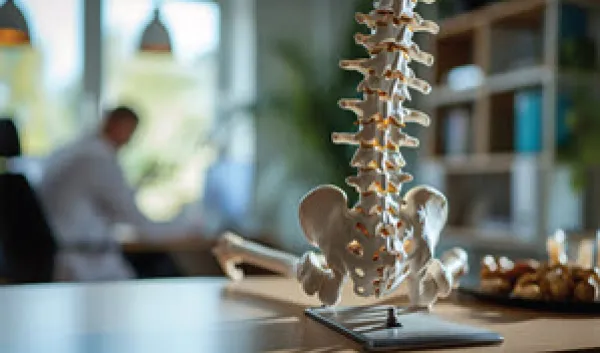Condition typically confirmed by imaging.
When a patient has scoliosis, their treatment regimen at your orthopedist could be long and varied, so it’s a given that coding for the condition and treatments can present challenges.
Scoliosis sufferers can be treated by orthopedists at any point in their treatment, from diagnosing the condition through surgeries —and everywhere in between. You’ll need to know all of the potential coding hurdles ahead of time to make sure you can make the most of these claims.
Read on for a primer on the diagnosis and treatment of scoliosis.

Scoliosis Often Identified During E/M
As with many diseases, the road to scoliosis treatment often begins with an office/outpatient evaluation and management (E/M) service, which you’d code with 99202 (Office or other outpatient visit for the evaluation and management of a new patient, which requires a medically appropriate history and/ or examination and straightforward medical decision making. When using total time on the date of the encounter for code selection, 15 minutes must be met or exceeded.) through 99215 (Office or other outpatient visit for the evaluation and management of an established patient, which requires a medically appropriate history and/or examination and high level of medical decision making. When using total time on the date of the encounter for code selection, 40 minutes must be met or exceeded.). Be observant, though; the physician might perform another E/M service — such as hospital inpatient or observation — before deciding on the procedure.
“The health care team will initially take a detailed medical history and may ask questions about recent growth,” according to Mayo Clinic. “During the physical exam, your provider may have your child stand and then bend forward from the waist, with arms hanging loosely, to see if one side of the rib cage is more prominent than the other.”
Your provider also may perform a neurological exam to check for muscle weakness, numbness, and reflexes.
Factor Imaging Tests Into Claim
“Plain X-rays can confirm the diagnosis of scoliosis and reveal the seriousness of the spinal curvature,” offers Mayo Clinic. When the surgeon takes X-rays to check for scoliosis, you’d report a code from the 72020 (Radiologic examination, spine, single view, specify level) through 72120 (Radiologic examination, spine, lumbosacral; bending views only, 2 or 3 views) code set.
To reduce the risk of radiation exposure, “your healthcare provider might suggest a type of imaging system that uses lower doses of radiation to create a 3D model of the spine. However, this system isn’t available at all medical centers. Ultrasound is another option, although it can be less precise in determining the seriousness of the scoliosis curve,” reports Mayo Clinic. Code these encounters based on the specifics in the procedure notes; contact your payer if you’re unsure about coding for these imaging services.
If the surgeon suspects that an underlying condition is causing the scoliosis, they might order magnetic resonance imaging (MRI). Report MRIs with a code from the 72141 (Magnetic resonance (eg, proton) imaging, spinal canal and contents, cervical; without contrast material) through 72158 (Magnetic resonance (eg, proton) imaging, spinal canal and contents, without contrast material, followed by contrast material(s) and further sequences; lumbar) code set.
Treatment Options Include Back Brace
If the patient has moderate scoliosis and is still growing, treatment might initially consist of wearing a back brace. “Wearing a brace won’t cure scoliosis or reverse the curve, but it usually prevents the curve from getting worse,” reports Mayo Clinic.
The codes for back brace fitting and adjustment can be found in the L section of HCPCS. These codes are typically reported by the entity that fabricates and fits the brace or orthosis, usually a specialist in orthotics and prosthetics.
Spinal Fusion Among Scoliosis Surgical Options
If the surgeon decides to operate to mitigate the scoliosis, there are several options. Check out each type of surgical treatment below:
Spinal fusion: In this procedure, “surgeons connect two or more of the bones in the spine together. … Pieces of bone or a bonelike material is placed between the vertebrae. Metal rods, hooks, screws or wires typically hold that part of the spine straight and still while the old and new bone material fuses together,” reports Mayo Clinic.
Report spinal fusions with one of the following codes:

Expanding rod: If the scoliosis is progressing rapidly at a young age, surgeons can attach one or two expandable rods along the spine that can adjust in length as the patient grows. The rods are lengthened every three to six months either with surgery or in the clinic using a remote control.
There are no specific codes for expanding rod treatment, so you should report 22899 (Unlisted procedure, spine). You would likely want to offer a comparison code along with an explanation as to why it is similar to the expanding rod treatment. You could label the 22899 claim with “insertion of spinal growth rod” or “expansion of spinal growth rod” to make things clearer to payers and compare it to one of the listed spinal instrumentation codes.
Vertebral body tethering: During this procedure, the surgeon places screws on the outside edge of the spinal curve, and threads a flexible cord through the screws. When the surgeon performs tethering, choose from the following codes:
